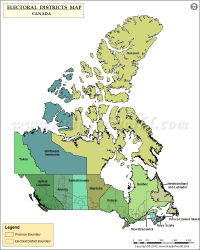Canadian Federal Election 2015
| Party | (Electoral Districts) | % of electoral districts | Number of votes | % of Votes |
|---|---|---|---|---|
| Liberal | 184 | 54.40% | 6769489 | 39.40% |
| Conservative | 100 | 29.60% | 5486779 | 32.00% |
| NDP-New Democratic Party | 43 | 12.70% | 3369172 | 19.60% |
| Bloc Québécois | 10 | 3.00% | 812941 | 4.70% |
| More… | ||||
About 2015 Canadian Federal Election
Canada is all set to witness the 2015 Canadian Federal Election, the date for canadian federal election 2015 is October 19, 2015 . In the elections, members will be elected to the House of Commons of the 42nd Parliament of Canada. As a result of the 2012 federal electoral redistribution, the number of electoral districts has been increased to 338. Additional seats based on population assigned to Alberta (6), British Columbia (6), Ontario (15), and Quebec (3).
 |
| Canada Electoral Districts |
The government of Canada is that of a parliamentary democracy, a federation, and a constitutional monarchy. The queen of the United Kingdom is the head of state of Canada and is officially represented by the Governor General.
Election process
The Parliament of Canada comprises two chambers – the House of Commons and the Senate. The House of Commons has 308 members, the Senate has 105 members who are appointed by the Governor General on the advice of the Prime Minister. The Senators are given permanent terms up to the age of 75.
The elections in Canada are administered by Elections Canada, which is an independent agency, and are governed by the Canada Elections Act.
Canada is divided into 338 constituencies. The voters are entitled to vote in the constituency in which they are registered and for one of the candidates who is standing in that particular constituency. Canada follows the system of “first-past-the-post.” According to this, the candidate who has the most votes in a riding gets elected to the House of Commons as a representative of that riding.
The elections will be held on October 19, 2015, and the canadian federal election polls 2015 would be open for 12 hours.
Political financing is describes by issues such as funding mechanisms, levels of democratic participation, fairness and transparency, etc. the political parties of Canada get the most significant portion of public funding during elections. This is based on what has been spent through electoral expense reimbursements. The primary sources of funding of Canada’s federal political parties are the political contributions from individuals which are subsidized through tax credits and per-vote subsidies.